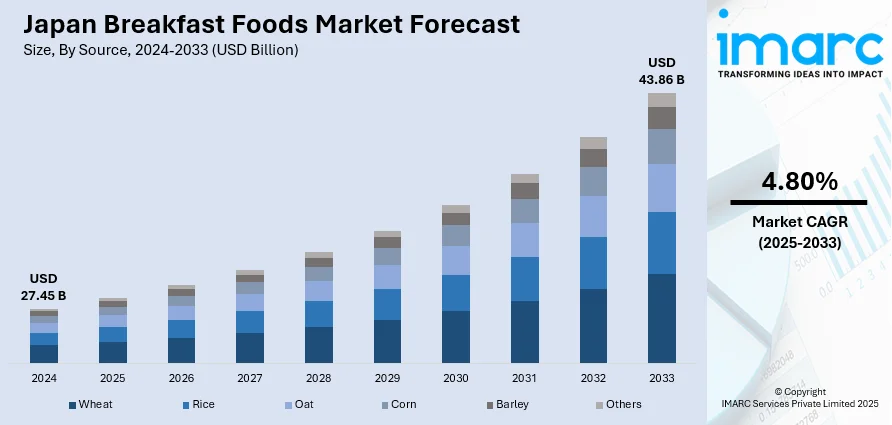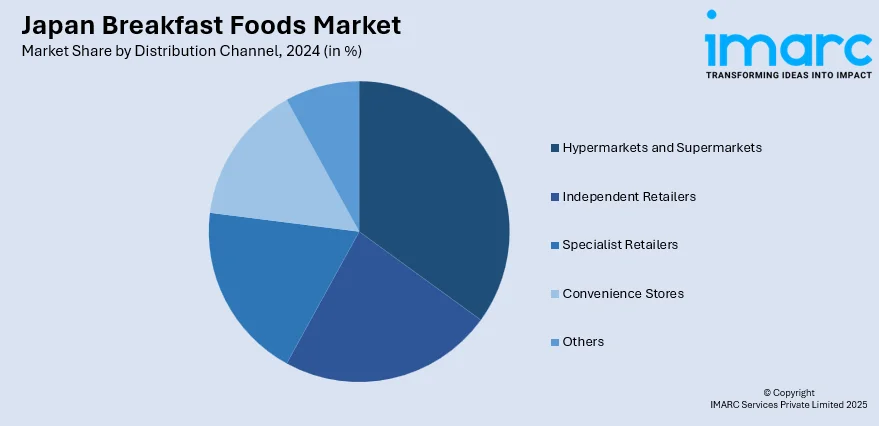
Japan Breakfast Foods Market Size, Share, Trends and Forecast by Source, Packaging Type, Distribution Channel, and Region, 2025-2033
Japan Breakfast Foods Market Overview:
The Japan breakfast foods market size reached USD 27.45 Billion in 2024. Looking forward, IMARC Group expects the market to reach USD 43.86 Billion by 2033, exhibiting a growth rate (CAGR) of 4.80% during 2025-2033. At present, Japanese consumers are looking for increasingly convenient and time-saving breakfast options. This trend, along with health awareness, is rising among Japanese consumers and influencing their breakfast choices. Apart from this, the noticeable shift in Japan’s breakfast culture, with western-style breakfast foods gaining popularity among consumers, is expanding the Japan breakfast foods market share.
|
Report Attribute
|
Key Statistics
|
|---|---|
|
Base Year
|
2024 |
|
Forecast Years
|
2025-2033
|
|
Historical Years
|
2019-2024
|
| Market Size in 2024 | USD 27.45 Billion |
| Market Forecast in 2033 | USD 43.86 Billion |
| Market Growth Rate 2025-2033 | 4.80% |
Japan Breakfast Foods Market Trends:
Rising Consumer Demand for Convenience
Japanese consumers are looking for increasingly convenient and time-saving breakfast options. The heightened need for convenience is facilitating the move towards ready-to-eat (RTE) and quick-to-prepare breakfast foods. Busy lives and the increased number of working professionals are necessitating individuals to choose breakfast products that involve little preparation. Therefore, companies are innovating by providing products like instant oats, pre-packaged sandwiches, and breakfast bars. These items are becoming popular as they meet the demand for fast meals that can be eaten on the run. Moreover, the single-serve packaging trend is gaining popular, as it offers a convenient and accessible way for busy people in the mornings. These convenience-led preferences are defining the development of the market for breakfast foods, with companies placing emphasis on providing more convenient and hassle-free food experiences. The IMARC Group predicts that the Japan convenience food market size is projected to attain USD 34,086.1 Million by 2033.

Increasing Health Consciousness Among Consumers
Health awareness is rising among Japanese consumers and influencing their breakfast food choices. Consumers are increasingly becoming more sensitive to the nutritional content of their food and favoring healthier, natural ingredients. Consequently, the market is seeing an increase in the demand for whole grains, low-sugar products, and foods high in essential vitamins and minerals. Demand for gluten-free and plant-based breakfast foods is also rising as a part of this transition toward healthier diets. Food companies are meeting this need by adding organic and functional ingredients to their products, including added fiber, probiotics, and superfoods. This trend is impacting product formulation and marketing strategies across brands, with brands highlighting the health aspects of their products. The ongoing increase in the demand for health-conscious breakfast foods is impelling the Japan breakfast foods market growth.
Cultural Shifts and Westernization of Breakfast Habits
There is a noticeable shift in Japan’s breakfast culture, with Western-style breakfast foods gaining popularity among consumers. Traditionally, Japanese breakfasts have consisted of rice, fish, and miso soup, but modern lifestyles and globalization are introducing more diverse breakfast options. Japanese consumers are embracing Western breakfast items such as cereal, toast, and smoothies, often as part of their morning routines. This cultural shift is being driven by younger generations who are more open to experimenting with international foods. As a result, Japanese manufacturers and international brands are capitalizing on this trend by offering products that blend Western flavors with traditional Japanese ingredients, such as miso-flavored granola or rice-based breakfast cereals. This fusion of Western and Japanese breakfast habits is reshaping the market, leading to the development of innovative products that appeal to evolving tastes and preferences. In 2024, Calbee launched Body Granola, which is a personalized cereal offering providing a customized mix of prebiotics to suit the consumer’s microbiome.
Japan Breakfast Foods Market Segmentation:
IMARC Group provides an analysis of the key trends in each segment of the market, along with forecasts at the country and regional levels for 2025-2033. Our report has categorized the market based on source, packaging type, and distribution channel.
Source Insights:
- Wheat
- Rice
- Oat
- Corn
- Barley
- Others
The report has provided a detailed breakup and analysis of the market based on the source. This includes wheat, rice, oat, corn, barley, and others.
Packaging Type Insights:
- Boxes
- Pouches
- Others
The report has provided a detailed breakup and analysis of the market based on the packaging type. This includes boxes, pouches, and others.
Distribution Channel Insights:

- Hypermarkets and Supermarkets
- Independent Retailers
- Specialist Retailers
- Convenience Stores
- Others
A detailed breakup and analysis of the market based on the distribution channel have also been provided in the report. This includes hypermarkets and supermarkets, independent retailers, specialist retailers, convenience stores, and others.
Regional Insights:
- Kanto Region
- Kansai/Kinki Region
- Central/ Chubu Region
- Kyushu-Okinawa Region
- Tohoku Region
- Chugoku Region
- Hokkaido Region
- Shikoku Region
The report has also provided a comprehensive analysis of all the major regional markets, which include Kanto Region, Kansai/Kinki Region, Central/ Chubu Region, Kyushu-Okinawa Region, Tohoku Region, Chugoku Region, Hokkaido Region, and Shikoku Region.
Competitive Landscape:
The market research report has also provided a comprehensive analysis of the competitive landscape. Competitive analysis such as market structure, key player positioning, top winning strategies, competitive dashboard, and company evaluation quadrant has been covered in the report. Also, detailed profiles of all major companies have been provided.
Japan Breakfast Foods Market Report Coverage:
| Report Features | Details |
|---|---|
| Base Year of the Analysis | 2024 |
| Historical Period | 2019-2024 |
| Forecast Period | 2025-2033 |
| Units | Billion USD |
| Scope of the Report | Exploration of Historical Trends and Market Outlook, Industry Catalysts and Challenges, Segment-Wise Historical and Future Market Assessment:
|
| Sources Covered | Wheat, Rice, Oat, Corn, Barley, Others |
| Packaging Types Covered | Boxes, Pouches, Others |
| Distribution Channels Covered | Hypermarkets and Supermarkets, Independent Retailers, Specialist Retailers, Convenience Stores, Others |
| Regions Covered | Kanto Region, Kansai/Kinki Region, Central/ Chubu Region, Kyushu-Okinawa Region, Tohoku Region, Chugoku Region, Hokkaido Region, Shikoku Region |
| Customization Scope | 10% Free Customization |
| Post-Sale Analyst Support | 10-12 Weeks |
| Delivery Format | PDF and Excel through Email (We can also provide the editable version of the report in PPT/Word format on special request) |
Key Questions Answered in This Report:
- How has the Japan breakfast foods market performed so far and how will it perform in the coming years?
- What is the breakup of the Japan breakfast foods market on the basis of source?
- What is the breakup of the Japan breakfast foods market on the basis of packaging type?
- What is the breakup of the Japan breakfast foods market on the basis of distribution channel?
- What is the breakup of the Japan breakfast foods market on the basis of region?
- What are the various stages in the value chain of the Japan breakfast foods market?
- What are the key driving factors and challenges in the Japan breakfast foods market?
- What is the structure of the Japan breakfast foods market and who are the key players?
- What is the degree of competition in the Japan breakfast foods market?
Key Benefits for Stakeholders:
- IMARC’s industry report offers a comprehensive quantitative analysis of various market segments, historical and current market trends, market forecasts, and dynamics of the Japan breakfast foods market from 2019-2033.
- The research report provides the latest information on the market drivers, challenges, and opportunities in the Japan breakfast foods market.
- Porter's five forces analysis assist stakeholders in assessing the impact of new entrants, competitive rivalry, supplier power, buyer power, and the threat of substitution. It helps stakeholders to analyze the level of competition within the Japan breakfast foods industry and its attractiveness.
- Competitive landscape allows stakeholders to understand their competitive environment and provides an insight into the current positions of key players in the market.
Need more help?
- Speak to our experienced analysts for insights on the current market scenarios.
- Include additional segments and countries to customize the report as per your requirement.
- Gain an unparalleled competitive advantage in your domain by understanding how to utilize the report and positively impacting your operations and revenue.
- For further assistance, please connect with our analysts.
 Request Customization
Request Customization
 Speak to an Analyst
Speak to an Analyst
 Request Brochure
Request Brochure
 Inquire Before Buying
Inquire Before Buying




.webp)




.webp)












